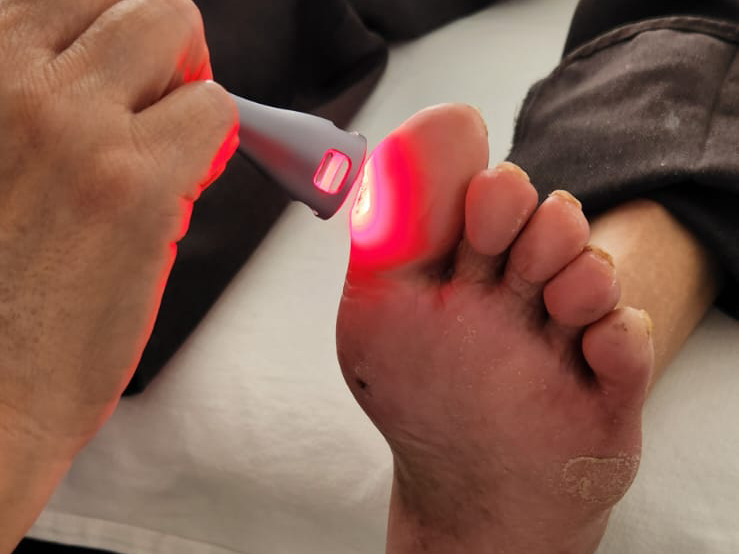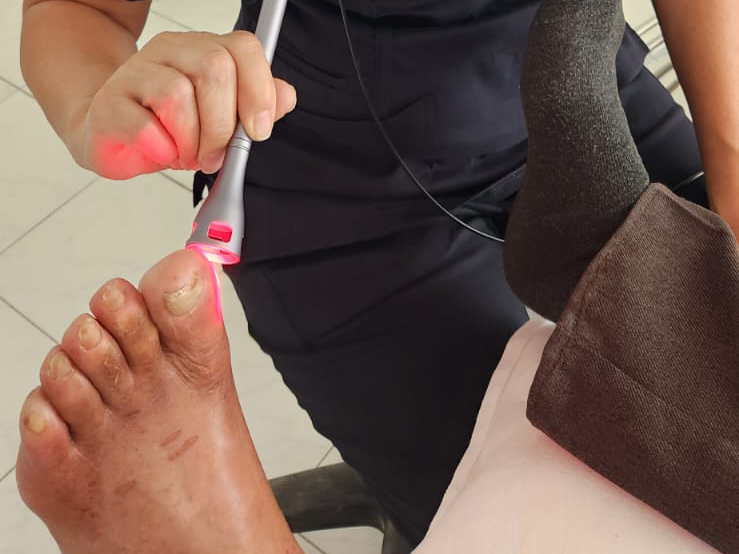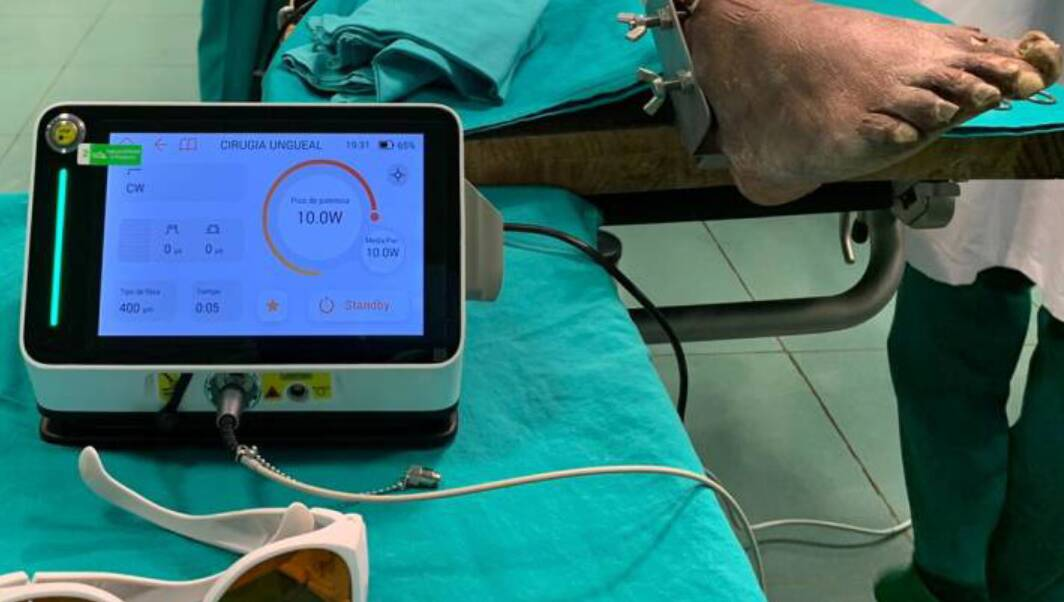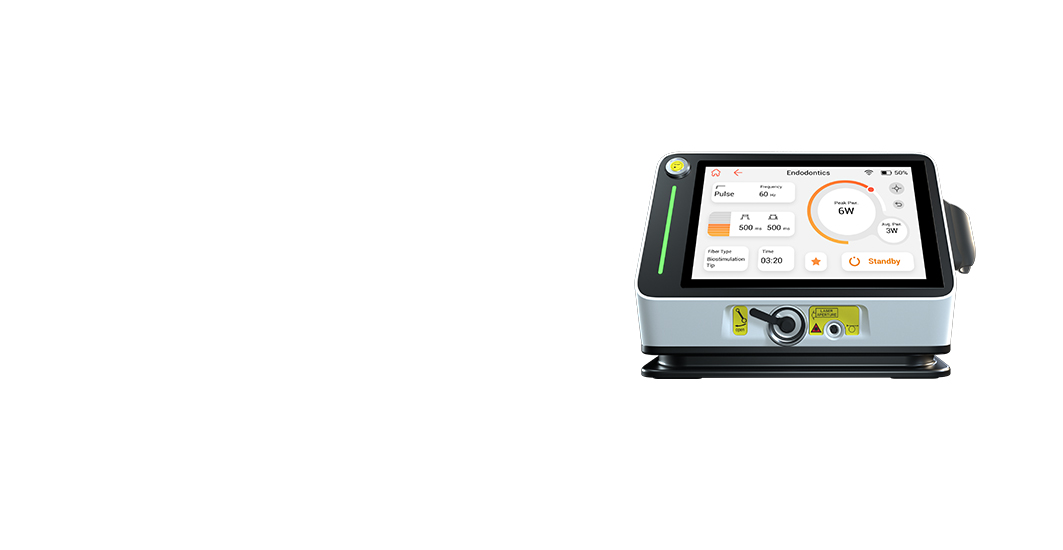Laser treatment for Podiatry
Podiatry is a medical specialty focused on diagnosing and treating conditions of the foot, ankle, and lower extremities. Key conditions include:
-
Onychomycosis (Nail Fungus):
A fungal infection of the nail, leading to discoloration, thickening, and crumbling.
-
Warts:
Caused by the human papillomavirus (HPV), commonly found on the feet.
-
Physical Therapy:
Used for chronic pain and inflammation in the feet and ankles, such as plantar fasciitis and Achilles tendinitis.
-
Diabetic Foot Care:
Essential for diabetic patients who are prone to ulcers and infections due to poor circulation and neuropathy.
To understand the technical basis of laser treatment, we first need to examine the laser wavelengths commonly used for various foot conditions and their specific mechanisms of action.
The Wavelength of Laser treatment For Podiatry
| Treatment Type | Common Wavelengths | Detailed Explanation |
| Laser Treatment for Warts | 980nm |
- Characteristics: Strong thermal effect and penetration
- Action: Selectively destroys wart tissue, seals blood vessels, cuts off nutrient supply - Effect: Promotes healing, reduces pain and inflammation |
| Laser Treatment for Diabetic Ulcers |
810nm
940nm 980nm |
- Characteristics: Biostimulatory effect and deep penetration
- Action: Enhances cellular metabolism and repair, improves blood circulation, anti-inflammatory and analgesic effects - Effect: Accelerates ulcer healing |
| Foot Therapy |
810nm
940nm 980nm |
- Characteristics: Deep tissue treatment and improved blood circulation
- Action: Relieves pain and inflammation, promotes tissue repair and regeneration - Effect: Enhances treatment outcomes, reduces symptoms |
| Laser Treatment for Nail Fungus | 980nm 1064nm |
- Characteristics: Deep penetration, targets fungi
- Action: Disrupts fungal biofilm, increases treatment efficacy - Effect: Promotes tissue repair, reduces recurrence rate |
Laser Treatment for Warts:
-
Common Wavelength: 980nm
-
Characteristics: The 980nm wavelength laser has a strong thermal effect and can deeply penetrate wart tissue.
-
Action: Selectively destroys wart tissue and seals blood vessels within the wart, cutting off its nutrient supply, which leads to the wart's shrinkage and eventual removal.
-
Effect: Safe and effective treatment process with significant pain and inflammation reduction, leading to quick recovery.
Laser Treatment for Diabetic Ulcers:

Common Wavelengths: 810nm, 940nm, 980nm
-
Characteristics: These wavelengths provide a good biostimulatory effect and deep tissue penetration, effectively targeting ulcerated areas.
-
Action: Lasers enhance cellular metabolism and ATP production, promoting cell repair and tissue regeneration; improve local blood circulation, increasing oxygen and nutrient supply; and have notable anti-inflammatory and analgesic effects.
Effect: Accelerates the healing process of diabetic ulcers, reduces complications, and improves patients' quality of life.
Foot Therapy:
Common Wavelengths: 810nm, 940nm, 980nm
Characteristics: These wavelengths are capable of deep tissue penetration, providing effective treatment for deep-seated issues.
Action: Relieves deep tissue pain and inflammation, improves blood circulation, and promotes tissue repair and regeneration.
Effect: Significantly reduces symptoms, enhances treatment efficacy, and accelerates patient recovery.
Laser Treatment for Onychomycosis:
- Common Wavelength: 1064nm 980nm
- Characteristics: The 1064nm wavelength laser has strong penetration capabilities, reaching deep into the nail and nail bed to target fungi.
- Action: Disrupts the fungal biofilm, improving medication penetration and treatment effectiveness, and promotes repair and regeneration of the nail and nail bed.
- Effect: Significantly enhances treatment outcomes, reduces recurrence rates, and helps restore healthy nails.
Having understood the technical foundation of laser treatment, we will now explore the various advantages of laser therapy for foot conditions.
The Benefits of Laser Treatment For Podiatry
| Treatment Type | Advantages |
| Laser Treatment for Onychomycosis |
1.Deep penetration, directly targets fungi
2.Disrupts fungal biofilm, increases treatment efficacy 3.Promotes tissue repair and regeneration 4.Reduces pain and inflammation 5.High efficiency, safe with minimal side effects |
| Laser Treatment for Warts |
1.Selective absorption, precise destruction of wart tissue
2.Seals blood vessels, cuts off nutrient supply 3.Promotes healing and regeneration 4.Reduces pain and inflammation 5.High safety, quick recovery |
| Laser Treatment for Diabetic Foot Ulcers |
1.Biostimulatory effect, enhances cellular metabolism
2.Improves blood circulation, increases oxygen supply 3.Significant anti-inflammatory and analgesic effects 4.Promotes collagen production 5.Non-invasive, highly efficient and safe |
| Foot Therapy |
1.Deep tissue treatment, relieves pain and inflammation
2.2. Improves blood circulation and tissue repair 3.Biostimulatory effect, increases ATP production 4.Significant anti-inflammatory and analgesic effects 5.Non-invasive, highly safe |
Laser Treatment for Onychomycosis(Nail Fungus):
Deep Penetration: Laser can deeply penetrate the nail to target fungi.
Disrupts Biofilm: Laser disrupts the fungal biofilm, enhancing treatment effectiveness.
Promotes Repair: Stimulates tissue repair and nail regeneration.
Reduces Pain and Inflammation: Laser therapy reduces associated discomfort.
High Efficiency and Safety: Effective treatment with minimal side effects.
Laser Treatment for Warts:
Selective Absorption: Laser selectively targets wart tissue without damaging surrounding skin.
Seals Blood Vessels: Cuts off nutrient supply by sealing blood vessels within the wart.
Promotes Healing: Enhances tissue healing and regeneration.
Reduces Pain and Inflammation: Minimizes discomfort and inflammation.
High Safety: Quick recovery with a high safety profile.
Laser Treatment for Diabetic Foot Ulcers:

Biostimulatory Effect: Enhances cellular metabolism and ATP production.
Improves Circulation: Increases local blood flow and oxygen supply.
Anti-inflammatory and Analgesic: Reduces inflammation and pain significantly.
Promotes Collagen Production: Stimulates fibroblast activity and collagen synthesis.
Non-invasive and Safe: Effective treatment with non-invasive techniques.
Foot Therapy:
Deep Tissue Treatment: Effectively relieves pain and inflammation in deep tissues.
Improves Circulation: Enhances blood flow and tissue repair.
Biostimulatory Effect: Increases ATP production, promoting cellular activity.
Anti-inflammatory and Analgesic: Reduces inflammation and pain significantly.
Non-invasive and Safe: Safe treatment method with quick recovery.
-
After understanding the wavelengths and advantages of laser treatment, it is essential to know the specific treatment schedules to get a complete picture of the entire treatment process.
Laser Treatment Schedules for Podiatry
| Treatment Type | Initial Assessment | Initial Treatment | Ongoing Treatment | Maintenance Treatment | Regular Follow-ups |
| Laser Treatment for Onychomycosis | 1 session | 1-2 sessions, 1-2 weeks apart | 3-4 sessions, 4-6 weeks apart | 1 session, every 6-12 months | Every 3-6 months |
| Laser Treatment for Warts | 1 session | 1-2 sessions, 1-2 weeks apart | 1-2 sessions, 2-4 weeks apart | 1 session, every 1 month | Every 3-6 months |
| Laser Treatment for Diabetic Foot Ulcers | 1 session | 2-3 sessions, 1 week apart | 4-6 sessions, 1-2 weeks apart | 1-2 sessions, every 1 month | Every 3-6 months |
| Foot Therapy | 1 session | 2-3 sessions, 1 week apart | 4-6 sessions, 1-2 weeks apart | 1-2 sessions, every 1 month | Every 3-6 months |
Based on the Laser Treatment Timelines for Foot Conditions
Laser Treatment for Onychomycosis
Conclusion: Laser treatment for onychomycosis offers a structured and efficient approach to manage fungal infections of the nails. The treatment cycle typically involves an initial assessment followed by several sessions spaced 1-2 weeks apart, and ongoing sessions every 4-6 weeks. Maintenance treatments and regular follow-ups every 3-6 months help prevent recurrence, offering a sustainable and effective solution with minimal side effects compared to traditional antifungal medications.
Laser Treatment for Warts

Conclusion: The laser treatment for warts is precise and effective, requiring only a few sessions spaced 1-2 weeks apart for initial treatment and additional sessions every 2-4 weeks for ongoing treatment. This approach significantly reduces the pain, inflammation, and recurrence associated with warts compared to traditional methods such as cryotherapy or surgical removal. Maintenance treatments every month and regular follow-ups ensure long-term results.
Laser Treatment for Diabetic Foot Ulcers
Conclusion: For diabetic foot ulcers, laser treatment provides enhanced healing through biostimulation, improving blood circulation and reducing inflammation. The treatment schedule involves initial sessions weekly and ongoing sessions every 1-2 weeks, with maintenance sessions every month. This frequent and consistent treatment schedule accelerates ulcer healing and minimizes complications, offering a superior alternative to conventional wound care.
Foot Therapy
Conclusion: Laser therapy for foot conditions like pain and inflammation is effective due to its deep tissue penetration and biostimulatory effects. Initial treatments are frequent, with 2-3 sessions per week, followed by ongoing sessions every 1-2 weeks and maintenance treatments monthly. Regular follow-ups every 3-6 months help sustain the benefits, making laser therapy a non-invasive, efficient, and safe option for foot pain and inflammation management.
Laser treatments for various foot conditions provide a well-structured and efficient approach, with distinct phases of initial, ongoing, and maintenance treatments. These treatments offer faster results, higher efficacy, reduced side effects, and improved healing compared to traditional methods. Regular follow-ups ensure sustained benefits and prevent recurrence, making laser therapy a highly effective and preferred option for managing foot conditions such as onychomycosis, warts, diabetic foot ulcers, and general foot therapy.
Sidebar
Latest Content
Related Products

